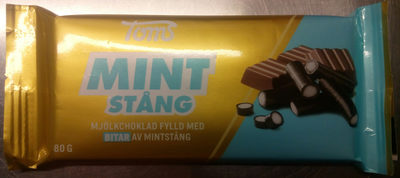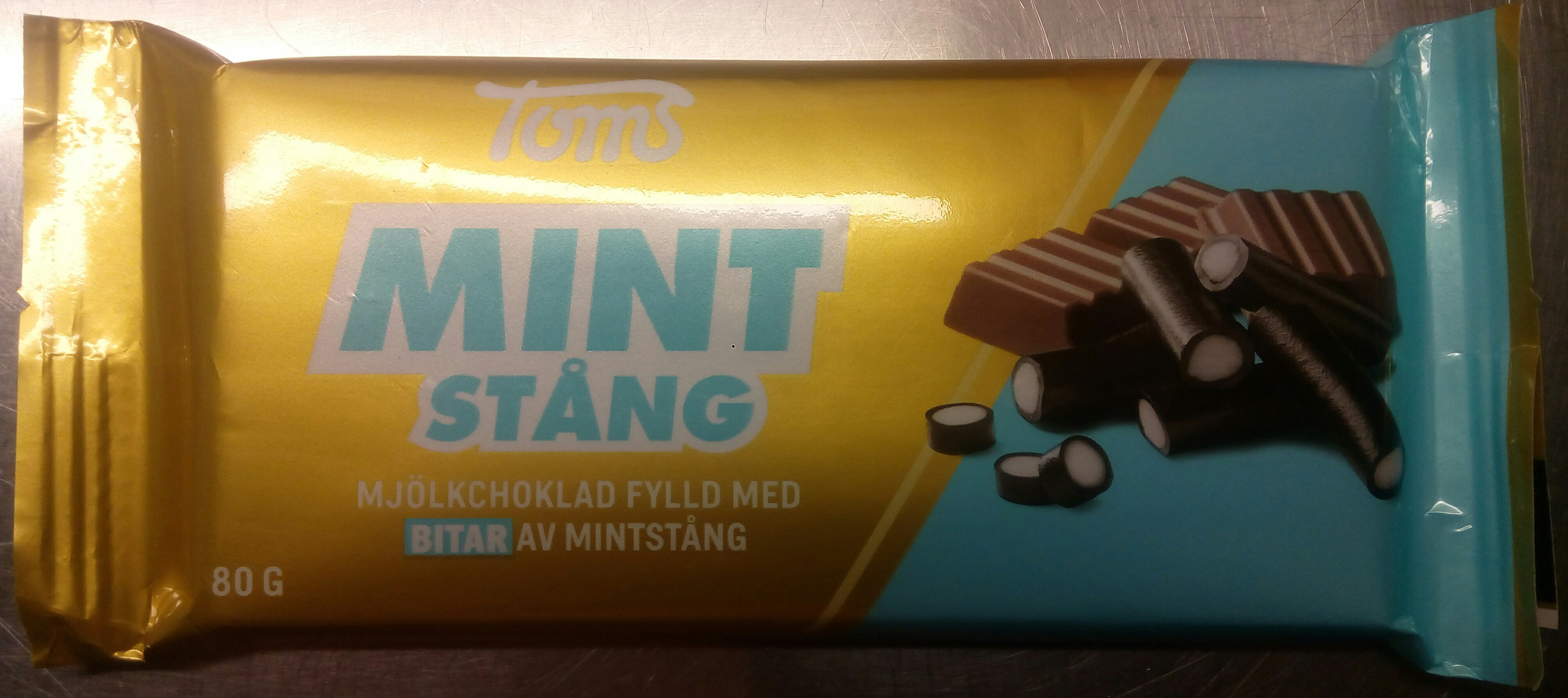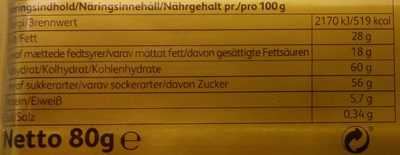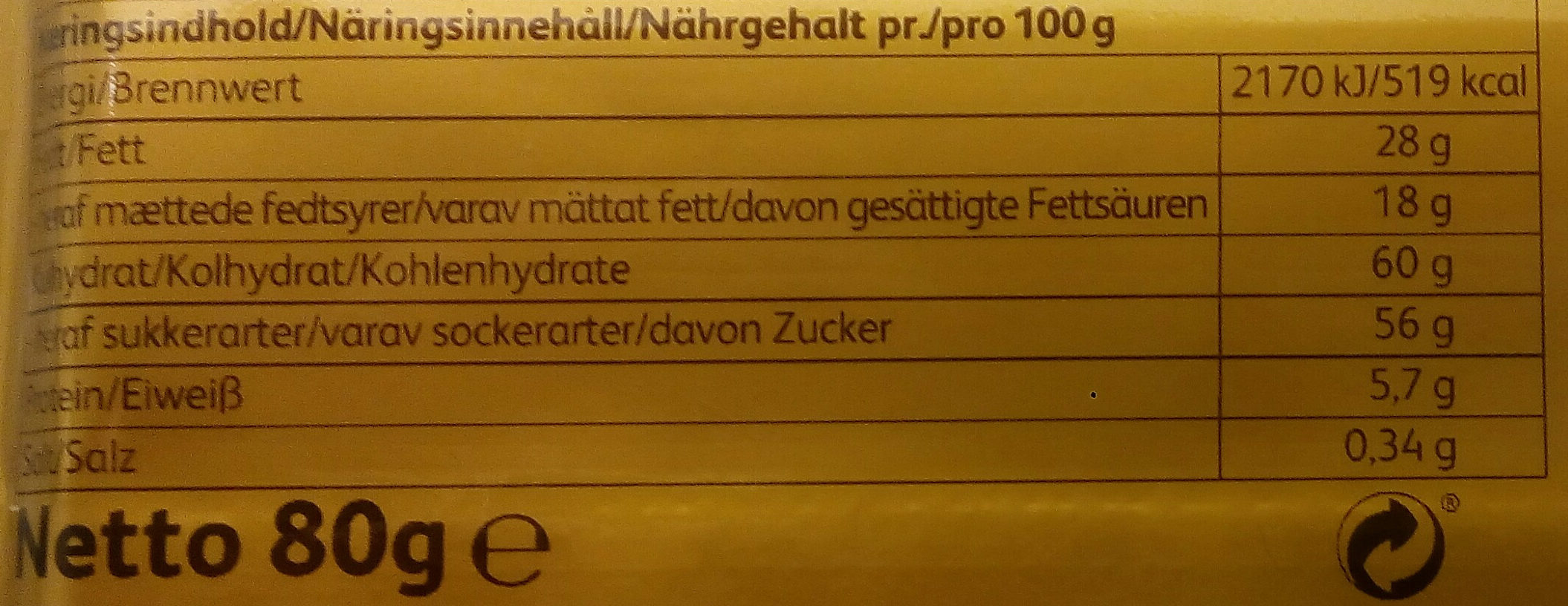Help us make food transparency the norm!
As a non-profit organization, we depend on your donations to continue informing consumers around the world about what they eat.
The food revolution starts with you!
Toms Mintstång - 80 g
Toms Mintstång - 80 g
This product page is not complete. You can help to complete it by editing it and adding more data from the photos we have, or by taking more photos using the app for Android or iPhone/iPad. Thank you!
×
Streckkod: 5774540131009 (EAN / EAN-13)
Vanligt namn: Mjölkchoklad med 19% fylld lakrits med pepparmyntsmak
Kvantitet: 80 g
Varumärken: Toms, Toms Confectionery Group
Kategorier: Snacks, Söta snacks, en:Cocoa and its products, Choklad, Mjölkchoklad
Etiketter, certifieringar, utmärkelser: Purveyor to the Royal Danish Court
Butiker: ICA Supermarket, DollarStore
Länder där såld: Sverige
Matching with your preferences
Hälsa
Ingredienser
-
24 ingredienser
Socker, sötmjölkspulver, kakaosmör, kakaomassa, glukos-fruktossirap, sirap, vetemjöl, emulgeringsmedel (lecitin, mono - och diglycerider av fettsyror), modifierad majs - och potatisstärkelse, helt härdat vegetabiliskt fett (palmkärna, kokos), rålakrits 0,3 %, fuktighetsbevarande medel (glycerol), förtjockningsmedel (gummi arabicum), salt, pepparmyntsolja 0,1 %, naturligt aromämne, vanilj.Allergener: Gluten, Mjölk, Sötmjölkspulver, SötmjölkspulverSpår: Nötter
Food processing
-
Ultra processed foods
Elements that indicate the product is in the 4 - Ultra bearbetade livsmedel och drycker group:
- Tillsats: E322 - Lecitiner
- Tillsats: E414 - Gummi arabicum
- Tillsats: E422 - Glycerol
- Tillsats: E471 - Mono- och diglycerider av fettsyror
- Ingrediens: Emulgeringsmedel
- Ingrediens: Glukos
- Ingrediens: Fuktighetsbevarande medel
- Ingrediens: Förtjockningsmedel
Food products are classified into 4 groups according to their degree of processing:
- Obearbetade eller minimalt bearbetade livsmedel
- Bearbetade kulinariska ingredienser
- Halvfabrikat
- Ultra processed foods
The determination of the group is based on the category of the product and on the ingredients it contains.
Tillsatser
-
E322 - Lecitiner
Lecithin: Lecithin -UK: , US: , from the Greek lekithos, "egg yolk"- is a generic term to designate any group of yellow-brownish fatty substances occurring in animal and plant tissues, which are amphiphilic – they attract both water and fatty substances -and so are both hydrophilic and lipophilic-, and are used for smoothing food textures, dissolving powders -emulsifying-, homogenizing liquid mixtures, and repelling sticking materials.Lecithins are mixtures of glycerophospholipids including phosphatidylcholine, phosphatidylethanolamine, phosphatidylinositol, phosphatidylserine, and phosphatidic acid.Lecithin was first isolated in 1845 by the French chemist and pharmacist Theodore Gobley. In 1850, he named the phosphatidylcholine lécithine. Gobley originally isolated lecithin from egg yolk—λέκιθος lekithos is "egg yolk" in Ancient Greek—and established the complete chemical formula of phosphatidylcholine in 1874; in between, he had demonstrated the presence of lecithin in a variety of biological matters, including venous blood, in human lungs, bile, human brain tissue, fish eggs, fish roe, and chicken and sheep brain. Lecithin can easily be extracted chemically using solvents such as hexane, ethanol, acetone, petroleum ether, benzene, etc., or extraction can be done mechanically. It is usually available from sources such as soybeans, eggs, milk, marine sources, rapeseed, cottonseed, and sunflower. It has low solubility in water, but is an excellent emulsifier. In aqueous solution, its phospholipids can form either liposomes, bilayer sheets, micelles, or lamellar structures, depending on hydration and temperature. This results in a type of surfactant that usually is classified as amphipathic. Lecithin is sold as a food additive and dietary supplement. In cooking, it is sometimes used as an emulsifier and to prevent sticking, for example in nonstick cooking spray.Källa: Wikipedia (Engelska)
-
E322i - Lecitin
Lecithin: Lecithin -UK: , US: , from the Greek lekithos, "egg yolk"- is a generic term to designate any group of yellow-brownish fatty substances occurring in animal and plant tissues, which are amphiphilic – they attract both water and fatty substances -and so are both hydrophilic and lipophilic-, and are used for smoothing food textures, dissolving powders -emulsifying-, homogenizing liquid mixtures, and repelling sticking materials.Lecithins are mixtures of glycerophospholipids including phosphatidylcholine, phosphatidylethanolamine, phosphatidylinositol, phosphatidylserine, and phosphatidic acid.Lecithin was first isolated in 1845 by the French chemist and pharmacist Theodore Gobley. In 1850, he named the phosphatidylcholine lécithine. Gobley originally isolated lecithin from egg yolk—λέκιθος lekithos is "egg yolk" in Ancient Greek—and established the complete chemical formula of phosphatidylcholine in 1874; in between, he had demonstrated the presence of lecithin in a variety of biological matters, including venous blood, in human lungs, bile, human brain tissue, fish eggs, fish roe, and chicken and sheep brain. Lecithin can easily be extracted chemically using solvents such as hexane, ethanol, acetone, petroleum ether, benzene, etc., or extraction can be done mechanically. It is usually available from sources such as soybeans, eggs, milk, marine sources, rapeseed, cottonseed, and sunflower. It has low solubility in water, but is an excellent emulsifier. In aqueous solution, its phospholipids can form either liposomes, bilayer sheets, micelles, or lamellar structures, depending on hydration and temperature. This results in a type of surfactant that usually is classified as amphipathic. Lecithin is sold as a food additive and dietary supplement. In cooking, it is sometimes used as an emulsifier and to prevent sticking, for example in nonstick cooking spray.Källa: Wikipedia (Engelska)
-
E414 - Gummi arabicum
Gum arabic: Gum arabic, also known as acacia gum, arabic gum, gum acacia, acacia, Senegal gum and Indian gum, and by other names, is a natural gum consisting of the hardened sap of various species of the acacia tree. Originally, gum arabic was collected from Acacia nilotica which was called the "gum arabic tree"; in the present day, gum arabic is collected from acacia species, predominantly Acacia senegal and Vachellia -Acacia- seyal; the term "gum arabic" does not indicate a particular botanical source. In a few cases so‐called "gum arabic" may not even have been collected from Acacia species, but may originate from Combretum, Albizia or some other genus. Producers harvest the gum commercially from wild trees, mostly in Sudan -80%- and throughout the Sahel, from Senegal to Somalia—though it is historically cultivated in Arabia and West Asia. Gum arabic is a complex mixture of glycoproteins and polysaccharides. It is the original source of the sugars arabinose and ribose, both of which were first discovered and isolated from it, and are named after it. Gum arabic is soluble in water. It is edible, and used primarily in the food industry as a stabilizer, with EU E number E414. Gum arabic is a key ingredient in traditional lithography and is used in printing, paint production, glue, cosmetics and various industrial applications, including viscosity control in inks and in textile industries, though less expensive materials compete with it for many of these roles. While gum arabic is now produced throughout the African Sahel, it is still harvested and used in the Middle East.Källa: Wikipedia (Engelska)
-
E422 - Glycerol
Glycerol: Glycerol -; also called glycerine or glycerin; see spelling differences- is a simple polyol compound. It is a colorless, odorless, viscous liquid that is sweet-tasting and non-toxic. The glycerol backbone is found in all lipids known as triglycerides. It is widely used in the food industry as a sweetener and humectant and in pharmaceutical formulations. Glycerol has three hydroxyl groups that are responsible for its solubility in water and its hygroscopic nature.Källa: Wikipedia (Engelska)
-
E471 - Mono- och diglycerider av fettsyror
Mono- and diglycerides of fatty acids: Mono- and diglycerides of fatty acids -E471- refers to a food additive composed of diglycerides and monoglycerides which is used as an emulsifier. This mixture is also sometimes referred to as partial glycerides.Källa: Wikipedia (Engelska)
Ingrediensanalys
-
Palmolja
Ingredienser som innehåller palmolja: Palmkärnolja
-
Icke-vegan
Non-vegan ingredients: HelmjölkspulverVissa ingredienser kunde inte kännas igen.
Vi behöver din hjälp!
You can help us recognize more ingredients and better analyze the list of ingredients for this product and others:
- Edit this product page to correct spelling mistakes in the ingredients list, and/or to remove ingredients in other languages and sentences that are not related to the ingredients.
- Add new entries, synonyms or translations to our multilingual lists of ingredients, ingredient processing methods, and labels.
If you would like to help, join the #ingredients channel on our Slack discussion space and/or learn about ingredients analysis on our wiki. Thank you!
-
Vegetarisk status okänd
Okända ingredienser: Modifierad-majs, Och-potatisstärkelse, Helt-härdat-vegetabiliskt-fett, Rålakrits, Pepparmyntsolja, Naturligt-aromämneVissa ingredienser kunde inte kännas igen.
Vi behöver din hjälp!
You can help us recognize more ingredients and better analyze the list of ingredients for this product and others:
- Edit this product page to correct spelling mistakes in the ingredients list, and/or to remove ingredients in other languages and sentences that are not related to the ingredients.
- Add new entries, synonyms or translations to our multilingual lists of ingredients, ingredient processing methods, and labels.
If you would like to help, join the #ingredients channel on our Slack discussion space and/or learn about ingredients analysis on our wiki. Thank you!
-
Details of the analysis of the ingredients
Vi behöver din hjälp!
Vissa ingredienser kunde inte kännas igen.
Vi behöver din hjälp!
You can help us recognize more ingredients and better analyze the list of ingredients for this product and others:
- Edit this product page to correct spelling mistakes in the ingredients list, and/or to remove ingredients in other languages and sentences that are not related to the ingredients.
- Add new entries, synonyms or translations to our multilingual lists of ingredients, ingredient processing methods, and labels.
If you would like to help, join the #ingredients channel on our Slack discussion space and/or learn about ingredients analysis on our wiki. Thank you!
: Socker, _sötmjölkspulver_, kakaosmör, kakaomassa, glukos-fruktossirap, sirap, _vetemjöl_, emulgeringsmedel (lecitin, mono- och diglycerider av fettsyror), modifierad majs, och potatisstärkelse, helt härdat vegetabiliskt fett (palmkärna, kokos), rålakrits 0.3%, fuktighetsbevarande medel (glycerol), förtjockningsmedel (gummi arabicum), salt, pepparmyntsolja 0.1%, naturligt aromämne, vanilj- Socker -> en:sugar - vegan: yes - vegetarian: yes - ciqual_proxy_food_code: 31016 - percent_min: 5.55555555555556 - percent_max: 96.3
- _sötmjölkspulver_ -> en:whole-milk-powder - vegan: no - vegetarian: yes - ciqual_food_code: 19021 - percent_min: 0.3 - percent_max: 48.3
- kakaosmör -> en:cocoa-butter - vegan: yes - vegetarian: yes - ciqual_food_code: 16030 - percent_min: 0.3 - percent_max: 32.3
- kakaomassa -> en:cocoa-paste - vegan: yes - vegetarian: yes - ciqual_proxy_food_code: 16030 - percent_min: 0.3 - percent_max: 24.3
- glukos-fruktossirap -> en:glucose-fructose-syrup - vegan: yes - vegetarian: yes - ciqual_food_code: 31077 - percent_min: 0.3 - percent_max: 19.5
- sirap -> en:syrup - vegan: yes - vegetarian: yes - percent_min: 0.3 - percent_max: 16.3
- _vetemjöl_ -> en:wheat-flour - vegan: yes - vegetarian: yes - ciqual_proxy_food_code: 9410 - percent_min: 0.3 - percent_max: 14.0142857142857
- emulgeringsmedel -> en:emulsifier - percent_min: 0.3 - percent_max: 12.3
- lecitin -> en:e322i - vegan: maybe - vegetarian: maybe - percent_min: 0.15 - percent_max: 12.3
- mono- och diglycerider av fettsyror -> en:e471 - vegan: maybe - vegetarian: maybe - from_palm_oil: maybe - percent_min: 0 - percent_max: 6.15
- modifierad majs -> sv:modifierad-majs - percent_min: 0.3 - percent_max: 10.9666666666667
- och potatisstärkelse -> sv:och-potatisstärkelse - percent_min: 0.3 - percent_max: 9.9
- helt härdat vegetabiliskt fett -> sv:helt-härdat-vegetabiliskt-fett - percent_min: 0.3 - percent_max: 9.02727272727273
- palmkärna -> en:palm-kernel-oil - vegan: yes - vegetarian: yes - from_palm_oil: yes - percent_min: 0.15 - percent_max: 9.02727272727273
- kokos -> en:coconut - vegan: yes - vegetarian: yes - ciqual_proxy_food_code: 15006 - percent_min: 0 - percent_max: 4.51363636363636
- rålakrits -> sv:rålakrits - percent_min: 0.3 - percent: 0.3 - percent_max: 0.3
- fuktighetsbevarande medel -> en:humectant - percent_min: 0.1 - percent_max: 0.3
- glycerol -> en:e422 - vegan: maybe - vegetarian: maybe - percent_min: 0 - percent_max: 0.3
- förtjockningsmedel -> en:thickener - percent_min: 0.1 - percent_max: 0.3
- gummi arabicum -> en:e414 - vegan: yes - vegetarian: yes - percent_min: 0 - percent_max: 0.3
- salt -> en:salt - vegan: yes - vegetarian: yes - ciqual_food_code: 11058 - percent_min: 0.1 - percent_max: 0.3
- pepparmyntsolja -> sv:pepparmyntsolja - percent_min: 0.1 - percent: 0.1 - percent_max: 0.1
- naturligt aromämne -> sv:naturligt-aromämne - percent_min: 0 - percent_max: 0.1
- vanilj -> en:vanilla - vegan: yes - vegetarian: yes - percent_min: 0 - percent_max: 0.1
Näring
-
Bad nutritional quality
⚠ ️Varning: mängden fibrer är inte angiven, eventuella positiv inverkan på betyget kunde inte beaktas.⚠ ️Warning: the amount of fruits, vegetables and nuts is not specified on the label, it was estimated from the list of ingredients: 0This product is not considered a beverage for the calculation of the Nutri-Score.
Positiva poäng: 0
- Proteiner: 3 / 5 (värde: 5.7, avrundat värde: 5.7)
- Fiber: 0 / 5 (värde: 0, avrundat värde: 0)
- Frukt, grönsaker, nötter och raps- / valnöt- / olivoljor: 0 / 5 (värde: -0.0505154079861114, avrundat värde: 0)
Negativa poäng: 27
- Energi: 6 / 10 (värde: 2170, avrundat värde: 2170)
- Socker: 10 / 10 (värde: 56, avrundat värde: 56)
- Mättat fett: 10 / 10 (värde: 18, avrundat värde: 18)
- Natrium: 1 / 10 (värde: 136, avrundat värde: 136)
The points for proteins are not counted because the negative points are greater or equal to 11.
Näringsvärde: (27 - 0)
Nutri-Score:
-
Näringsvärden
-
Fett i hög kvantitet (28%)
What you need to know- A high consumption of fat, especially saturated fats, can raise cholesterol, which increases the risk of heart diseases.
Recommendation: Limit the consumption of fat and saturated fat- Choose products with lower fat and saturated fat content.
-
Mättat fett i hög kvantitet (18%)
What you need to know- A high consumption of fat, especially saturated fats, can raise cholesterol, which increases the risk of heart diseases.
Recommendation: Limit the consumption of fat and saturated fat- Choose products with lower fat and saturated fat content.
-
Sockerarter i hög kvantitet (56%)
What you need to know- A high consumption of sugar can cause weight gain and tooth decay. It also augments the risk of type 2 diabetes and cardio-vascular diseases.
Recommendation: Limit the consumption of sugar and sugary drinks- Sugary drinks (such as sodas, fruit beverages, and fruit juices and nectars) should be limited as much as possible (no more than 1 glass a day).
- Choose products with lower sugar content and reduce the consumption of products with added sugars.
-
Salt i måttlig kvantitet (0.34%)
What you need to know- A high consumption of salt (or sodium) can cause raised blood pressure, which can increase the risk of heart disease and stroke.
- Many people who have high blood pressure do not know it, as there are often no symptoms.
- Most people consume too much salt (on average 9 to 12 grams per day), around twice the recommended maximum level of intake.
Recommendation: Limit the consumption of salt and salted food- Reduce the quantity of salt used when cooking, and don't salt again at the table.
- Limit the consumption of salty snacks and choose products with lower salt content.
-
-
Näringsfakta
Näringsfakta Som såld
för 100 g / 100 mlCompared to: Mjölkchoklad Energi 2 170 kj
(519 kcal)−4 % Fett 28 g −12 % Mättat fett 18 g −3 % Kolhydrat 60 g +7 % Sockerarter 56 g +5 % Fiber ? Protein 5,7 g −0 % Salt 0,34 g +10 % Fruits‚ vegetables‚ nuts and rapeseed‚ walnut and olive oils (estimate from ingredients list analysis) −0,051 %
Miljö
-
Eco-Score E - Mycket hög miljöpåverkan
The Eco-Score is an experimental score that summarizes the environmental impacts of food products.→ The Eco-Score was initially developped for France and it is being extended to other European countries. The Eco-Score formula is subject to change as it is regularly improved to make it more precise and better suited to each country.Life cycle analysis
-
Average impact of products of the same category: D (Score: 38/100)
Kategori: Milk chocolate bar
Kategori: Milk chocolate bar
- PEF environmental score: 0.78 (the lower the score, the lower the impact)
- including impact on climate change: 12.74 kg CO2 eq/kg of product
Stage Impact Jordbruk
43.5 %Bearbetar
50.8 %Förpackning
1.3 %Transportation
3.7 %Distribution
0.6 %Consumption
0.0 %
Bonuses and maluses
-
Missing origins of ingredients information
Malus: -5
⚠ ️ The origins of the ingredients of this product are not indicated.
If they are indicated on the packaging, you can modify the product sheet and add them.
If you are the manufacturer of this product, you can send us the information with our free platform for producers.
-
Ingredients that threatens species
Malus: -10
Contains palm oil
Tropical forests in Asia, Africa and Latin America are destroyed to create and expand oil palm tree plantations. The deforestation contributes to climate change, and it endangers species such as the orangutan, the pigmy elephant and the Sumatran rhino.
-
Packaging with a medium impact
Malus: -10
Form Material Återvinning Impact Okänd Plast Hög ⚠ ️ The information about the packaging of this product is not sufficiently precise (exact shapes and materials of all components of the packaging).⚠ ️ For a more precise calculation of the Eco-Score, you can modify the product page and add them.
If you are the manufacturer of this product, you can send us the information with our free platform for producers.
Eco-Score for this product
-
Impact for this product: E (Score: 13/100)
Produkt: Toms Mintstång - 80 g
Life cycle analysis score: 38
Sum of bonuses and maluses: -25
Final score: 13/100
-
Carbon footprint
-
Equal to driving 6.6 km in a petrol car
1274 g CO² per 100g of product
The carbon emission figure comes from ADEME's Agribalyse database, for the category: Milk chocolate bar (Source: ADEME Agribalyse Database)
Stage Impact Jordbruk
31.2 %Bearbetar
65.4 %Förpackning
0.8 %Transportation
2.4 %Distribution
0.1 %Consumption
0.0 %
Förpackning
-
Packaging with a medium impact
-
Packaging parts
(Plast)
-
Packaging materials
Material % Packaging weight Packaging weight per 100 g of product Plast
-
Transportation
-
Origins of ingredients
Missing origins of ingredients information
⚠ ️ The origins of the ingredients of this product are not indicated.
If they are indicated on the packaging, you can modify the product sheet and add them.
If you are the manufacturer of this product, you can send us the information with our free platform for producers.Add the origins of ingredients for this product Add the origins of ingredients for this product
Hotade arter
-
Contains palm oil
Drives deforestation and threatens species such as the orangutan
Tropical forests in Asia, Africa and Latin America are destroyed to create and expand oil palm tree plantations. The deforestation contributes to climate change, and it endangers species such as the orangutan, the pigmy elephant and the Sumatran rhino.
Report a problem
-
Incomplete or incorrect information?
Category, labels, ingredients, allergens, nutritional information, photos etc.
If the information does not match the information on the packaging, please complete or correct it. Open Food Facts is a collaborative database, and every contribution is useful for all.
Datakällor
Produkt tillagd den av olofolleola4
Senast ändrad produktsida på av packbot.
Produktsida också redigerad av openfoodfacts-contributors.










